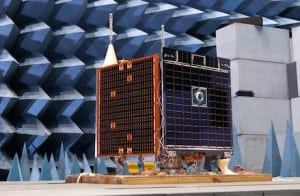Latest News
[Via Satellite 06-10-2014] Executives from Com Dev International said they are using the explosive growth of the company’s subsidiary exactEarth to compensate for the continued slump in U.S. defense sales. Commercial sector revenues increased 33.2 percent in Q2, whereas Com Dev’s civil and defense programs still showed the effects of reduced U.S. government spending, with respective revenue decreases of 27.7 percent and 41.2 percent.
“ExactEarth has really come into its own as a business, and this past quarter demonstrates that,” said Michael Pley, CEO of Com Dev International. “It has just about its entire infrastructure in place: five of the eight satellites in its constellation with three more already built and expected to be launched in 2015, a ground network, a data processing center and an operations center.”
Earnings Before Interest, Taxes, Depreciation and Amortization (EBITDA) for exactEarth increased from $0.3 million in Q2 2013 to $1 million in Q2 2014, and the subsidiary achieved $9.6 million in renewal contracts and new customer orders. Peter Mabson, president of exactEarth said that of the $9.6 million, all but roughly $800,000 was reoccurring from existing customers. ExactEarth saw a 51.7 percent increase in revenue during the second quarter of 2014, compared to the same quarter the prior fiscal year. In contrast, revenue for Com Dev declined slightly from last year’s Q2 earnings of $55.2 million to $54.3 million in Q2 2014. The company is seeking more ways to increase profits from Automatic Identification System (AIS) vessel tracking services.
“ExactEarth is also expanding its product offering, which is driving further sales growth,” explained Pley. “One high-margin initiative is the resale of large archives of unique vessel tracking data. This data is being used for planning and density studies by coast authorities as well as environmental studies.”
In partnership with SRT, exactEarth is developing new technology to track smaller vessels. Pley said that, though this would “take a number of years to fully deploy it will significantly expand exactEarth’s markets since it’s estimated that there are more eight million such vessels worldwide.” SRT and exactEarth are launching the capability now and expect initial income from this market to begin this year. Additionally, Com Dev is looking into new acquisitions in Southern California and expects to make an announcement before the end of the year.
Pley added that the constellation plans outlined earlier do not reflect the status of the Maritime Monitoring and Messaging Microsatellite, or M3M satellite. The Canadian government pulled the spacecraft from its scheduled June launch aboard a Soyuz rocket due to Russian actions in Ukraine. The M3M satellite was originally scheduled to begin service in September 2014.
“We had mitigation plans prepared for all of this, and we expect those to be concluded within the next couple of months,” said Pley, explaining that the Canadian government is currently assisting the company in finding an alternative route to space. “Those negotiations are still going on with the Canadian government and launch providers in terms of fixing that specific date, so we won’t be able to announce a date until all of that is in place, and exactEarth itself is in negotiations bringing alternate capacity in place,” he added.
The Canadian Space Agency (CSA) and Public Works Government Services Canada (PWGSC) ordered the satellite for Canada’s Department of National Defence. Com Dev constructed the M3M satellite, and exactEarth acquired a commercial data-sharing license to use it for AIS tracking services. To alleviate the satellite’s absence, Com Dev is collaborating with the Canadian government to offset potentially significant revenue losses. Additionally, Com Dev is working with CSA on four other unrelated microsatellite missions for meteorological and environmental purposes.
“There are other negotiations going on with the Canadian government with exactEarth and Com Dev related to other mitigations of this action, and so all of this we should be able to report on in due course, but can’t at this time,” said Pley.
Stay connected and get ahead with the leading source of industry intel!
Subscribe Now